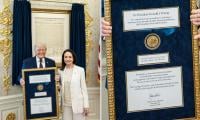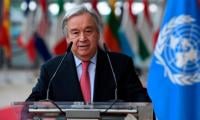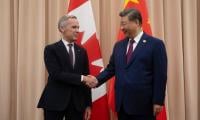Pakistan’s external account gap to reach $11.5bln in three years
ISLAMABAD: Pakistan’s external account financing gap is likely to touch $11.5 billion by 2019/20 and the government may resort to the International Monetary Fund (IMF) to avert possible payment default on foreign obligations, economist Ashfaque Hassan Khan said on Tuesday.
Khan forecast that the financing gap would reach $6 billion in 2016/17, $6.5 billion in 2017/18, $10.1 billion in 2018/19 and $11.5 billion in 2019/20. “Pakistan would not have other option but to seek fresh bailout package from the IMF,” he said, addressing a pre-budget seminar, organised by Comsats Institute of Information and Technology.
Khan, former advisor to the finance ministry alleged that the finance minister Ishaq Dar brought changes into the definition of debt through the last year’s finance bill. The Fiscal Responsibility and Debt Limitation Act (FRDLA) 2016 excluded certain headings from the domain of the debt, which is inconsistent with the definition, being used by the State Bank of Pakistan as well as the IMF and the World Bank.
He projected that the country’s external debt would reach $110 billion by 2019/20 or 365 percent of exports, $97.8 billion in 2018/19 and $88.5 billion in 2017/18. With a changed definition in accordance with the FRDLA 2016, Khan said the external debt stood at $57.5 billion, while it amounted to $73 billion in accordance with the previous and ‘acceptable’ definition.
Hafiz Pasha, ex-finance minister, said the optimism about the economy is not correct as the economic situation would be again heading back to the level of 2013 when the Pakistan Muslim League (Nawaz) took reins of power. The external debt touched $73 billion and the current account deficit is widening, resulting into drawdown of foreign currency reserves, Pasha added.
On China-Pakistan Economic Corridor (CPEC), he said that there is no need to discriminate against local companies by providing incentives to Chinese companies. Pakistan’s exports to China slumped 45 percent in the last three years, while imports increased 35 percent because of the faulty trade regime, Pasha said. India is the ultimate beneficiary of wrong policy prescription.
He further said agriculture sector has largely been ignored. The PML-N government announced agriculture package of Rs341 billion, but IMF stopped its implementation. Shahid Hafiz Kardar, ex-governor of State Bank of Pakistan said the country's exports are declining and the current account deficit jumped to $6.5 billion during the first nine months of the current fiscal against $4.9 billion a year ago. The widening current account deficit resulted into drawdown of foreign exchange reserves of $1.8 billion.
Kardar said the fragmented policies are negatively affecting exports and the IMF program caused more damage to the country’s export earnings because the cost of input for exports has gone up manifold.
The overvalued exchange rate also caused damage to exports, he said. Pakistani rupee appreciated one percent but currencies of many comparable economies devalued. Indian currency depreciated 30 percent, Malaysian 38 percent and Indonesian 38 percent.
Sakib Sherani, a renowned economist said only 0.24 percent of the country’s population are filing their income tax returns. “Only one in 400 individuals files their returns,” Sherani said. “The personal income tax contributes one percent of GDP in Pakistan, while in India it is 2.7 percent of GDP.”
He further said the development funding to the tune of Rs22 billion resulted into achievement of one percent growth in 2004. The same percentage point of growth would now require Rs115 to Rs120 billion in development spending.
-
 Trump Accepts Nobel Peace Medal From Machado: What It Means For Venezuela Politics?
Trump Accepts Nobel Peace Medal From Machado: What It Means For Venezuela Politics? -
 Late-night Snacking Linked To Higher Risk Of Liver Disease
Late-night Snacking Linked To Higher Risk Of Liver Disease -
 John Mellencamp Gives Update On Daughter Teddi's Health Struggles: 'She's Suffering'
John Mellencamp Gives Update On Daughter Teddi's Health Struggles: 'She's Suffering' -
 ‘Disturbing Developments’ Start To Follow Prince William, Kate: ‘This Has The Makings Of A Crisis’
‘Disturbing Developments’ Start To Follow Prince William, Kate: ‘This Has The Makings Of A Crisis’ -
 Pamela Anderson Breaks Silence On Fallout With Ex-Tommy Lee: 'I Miss Him'
Pamela Anderson Breaks Silence On Fallout With Ex-Tommy Lee: 'I Miss Him' -
 Andrew Warned: ‘You’re Gonna Add Your Own Final Nail In The Coffin Of Reputation’
Andrew Warned: ‘You’re Gonna Add Your Own Final Nail In The Coffin Of Reputation’ -
 Ben Affleck Doesn't Want His Kids To Join Showbiz: Here's Why
Ben Affleck Doesn't Want His Kids To Join Showbiz: Here's Why -
 George R.R. Martin Calls 'House Of The Dragon' S3 'not My Story'
George R.R. Martin Calls 'House Of The Dragon' S3 'not My Story' -
 Jessi Ngatikaura Gets Real About ‘identity Crisis’ From Facial Surgery
Jessi Ngatikaura Gets Real About ‘identity Crisis’ From Facial Surgery -
 Timothy Busfield Faces Potential 15-year Prison Sentence If Convicted
Timothy Busfield Faces Potential 15-year Prison Sentence If Convicted -
 Kim Kardashian Gushes Over 'baby Girl' Chicago As She Turns 8
Kim Kardashian Gushes Over 'baby Girl' Chicago As She Turns 8 -
 Drew Barrymore Reflects Heartbreaking Body Shaming She Faced At Just 10
Drew Barrymore Reflects Heartbreaking Body Shaming She Faced At Just 10 -
 Pamela Anderson Felt 'weird' Seeing Seth Rogen After 'Pam & Tommy'
Pamela Anderson Felt 'weird' Seeing Seth Rogen After 'Pam & Tommy' -
 Kelly Clarkson Discovers A Shark Named In Her Honour
Kelly Clarkson Discovers A Shark Named In Her Honour -
 HBO Mulls Major 'Game Of Thrones' Spin-off Focusing On A Stark
HBO Mulls Major 'Game Of Thrones' Spin-off Focusing On A Stark -
 Ashton Kutcher Says He's Proud Of Demi Moore
Ashton Kutcher Says He's Proud Of Demi Moore



